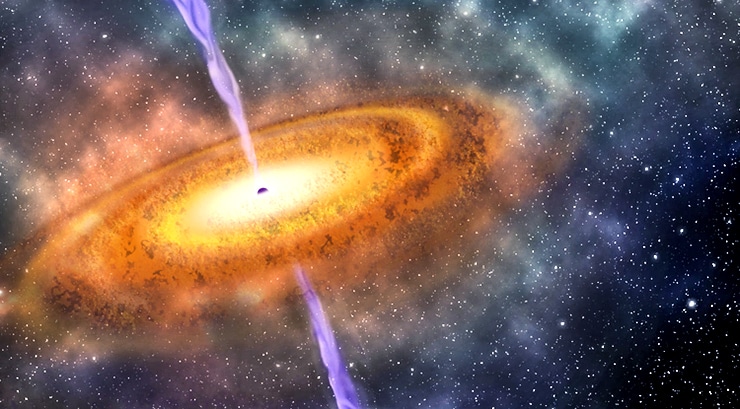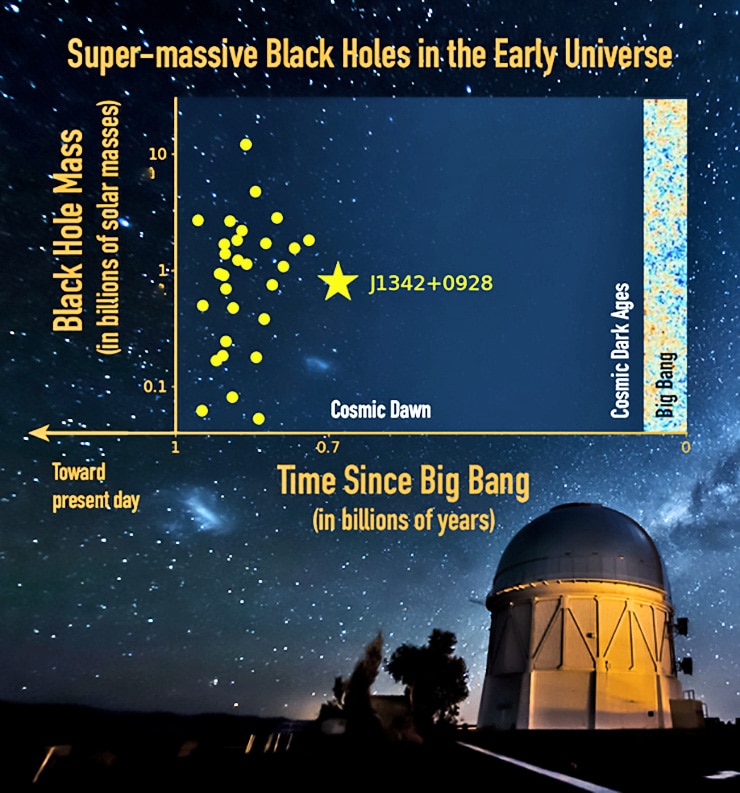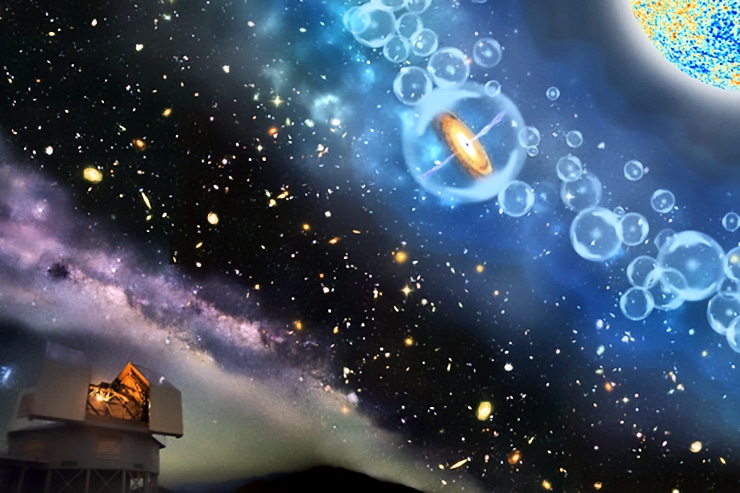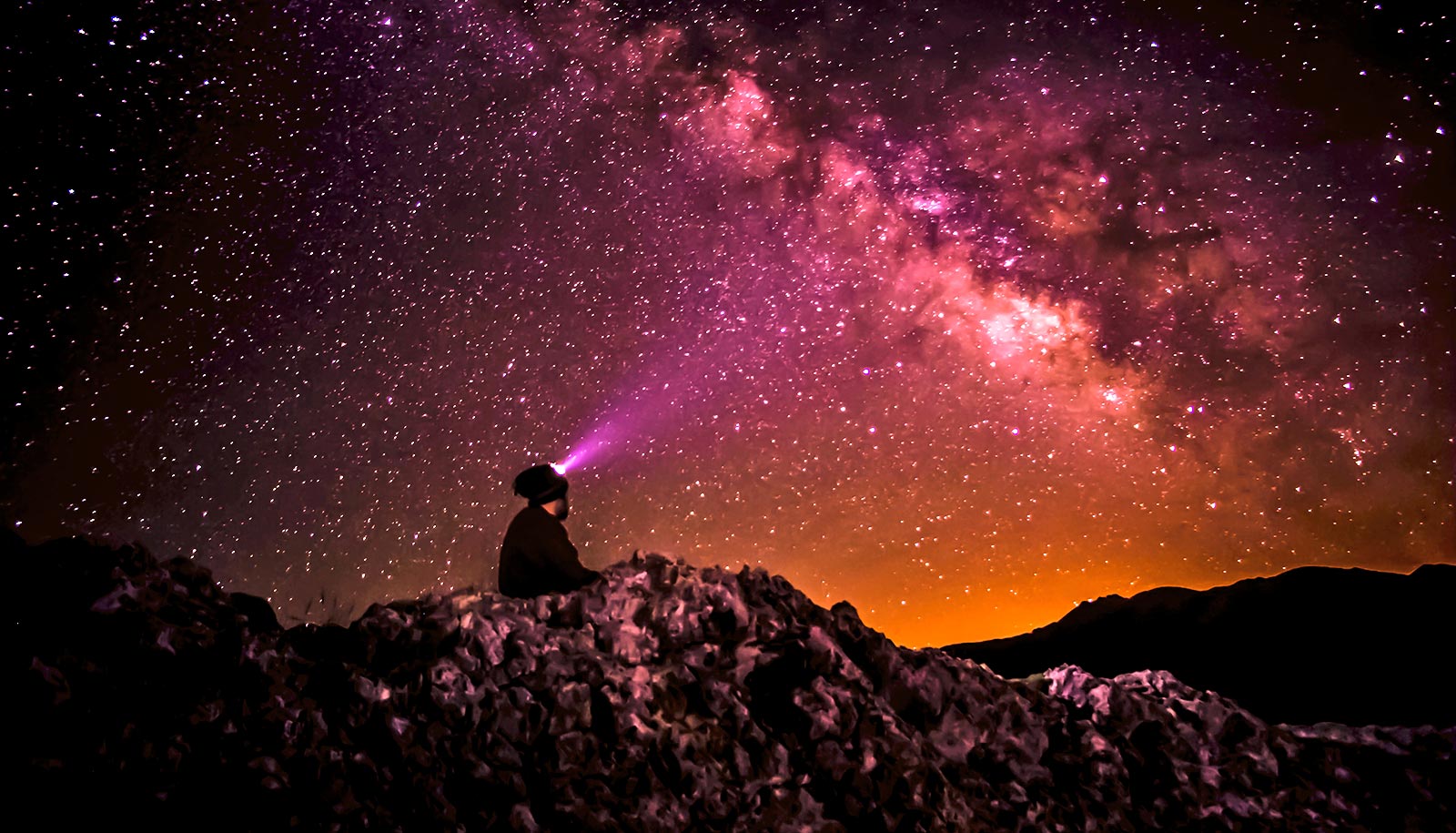Astronomers have discovered the most distant quasar ever known.
Supermassive black holes lurk at the centers of many galaxies. While some—like the black hole at the center of our own Milky Way—live quiet lives, occasionally snacking on a star or two, others feed voraciously, consuming gas and stars and growing rapidly in mass.
To understand when supermassive black holes first appeared, astronomers scan the skies for actively-feeding black holes (known as quasars) from the universe’s distant past. The latest discovery, from a team led by Eduardo Bañados of Carnegie Observatories and published in the journal Nature, is a record-breaker.

Because the universe has been expanding since the Big Bang, the more distant a cosmic object lies from an Earth-based observer, the faster it speeds away.
“The new object is so far away that it is undetectable in visible light.”
Astronomers can measure this speed by taking advantage of the Doppler effect: Much like the siren of an ambulance is heard at lower frequencies the faster it is speeding away from a pedestrian’s ears, the light coming from a distant cosmic object is shifted toward longer and longer wavelengths, in other words, into the red visible light and all the way into the near-infrared and infrared.
“The new object is so far away that it is undetectable in visible light,” explains study coauthor Xiaohui Fan, a professor at the University of Arizona’s Steward Observatory. “It is missing in very deep visible light images, with its light shifted completely into the infrared, and that tells us it is extremely far away.”
The new quasar is spotted at a redshift of 7.54, when the universe was only 690 million years old, or 5 percent of its current age. The universe was rapidly changing at this time. The first galaxies were appearing, and their energetic radiation had begun to ionize the surrounding intergalactic gas, illuminating and forever transforming the universe from neutral to ionized.
The discovery that the new quasar resides in a primarily neutral universe places it solidly in this era, at the edge of cosmic dawn.
‘A behemoth black hole’
Despite its young age, the quasar harbors a whopper of a black hole—800 million times the mass of the sun.
For Fan, it is amazing to discover so massive a black hole so early in cosmic history.
“The new quasar is itself one of the first galaxies, and yet it already harbors a behemoth black hole as massive as others in the present-day universe,” says Fan, who was part of a team that in 2015 discovered a quasar that still holds the record of being the most massive black hole ever found in the early universe.

Now the discovery of a smaller but more distant cousin challenges our understanding of the early growth of supermassive black holes and their host galaxies.
Quasars such as J1342+0928 are rare. The study that revealed the existence of J1342+0928 searched one-tenth of the entire sky, yielding only one quasar at this epoch. To pick out these rare sources from the millions of sources in the sky, the researchers employed a clever selection technique. They used archival data to search for sources that are bright in the infrared (beyond 1 micron) but undetected in the z-band, which is in the visible light spectrum (just short of 1 micron).
Deep z-band data covering a large swath of sky was therefore critical to the study. Luckily, just such a data set is now available from the DECam Legacy Survey, or DECaLS, that is being carried out with the Dark Energy Camera on the Blanco 4-m telescope at the Cerro Tololo Inter-American Observatory.

The research team also used infrared data sets from the Wide-field Infrared Survey Explorer, or WISE, and the United Kingdom Infrared Telescope Infrared Deep Sky Survey, or UKIDSS, Large Area Survey. Spectra taken with the near-infrared spectrograph on the Gemini North Telescope were used to measure the mass of the black hole.
“DECaLS was designed from the ground up as a public project, so it is wonderful to see the data enabling exciting discoveries that are pushing the boundaries of the known universe,” says Arjun Dey of the National Optical Astronomy Observatory, one of the co-leads of the DECaLS survey.
Quasar blasts through ‘fog’ to show distant galaxy
“Paradoxically, the non-detection of this source in the DECaLS data is what makes it so interesting and identifies it as a very distant object,” explains David Schlegel of the Lawrence Berkeley National Laboratory, the other co-lead of the DECaLS survey.
Still searching
Fan speculates that the new quasar—as remarkable as it is—is “probably just an early bloomer. If it is located in a denser-than-average part of the universe, it could get an earlier start in life and grow more quickly.”
He suspects that despite its precocious youth, J1342+0928 eventually settled down to life at a more measured pace, becoming a more typical supermassive black hole at the center of a large elliptical galaxy.
The reported result is part of a longer-term search for the earliest quasars. The research team is adopting a similar strategy in its exploration of a larger area of sky to track down and study the earliest quasars. How long will J1342+0928 remain the record holder? Only time will tell.
Rare quasars measure ripples in ‘cosmic web’
“The physics of how black holes form in the first place, and how they grow into these voraciously feeding behemoths, aren’t very well constrained yet,” Fan says.
Discoveries such as this one provide researchers with more data that help narrow down the parameters that bring these objects into existence and, ultimately, tell us about how the universe came to be and where it is headed.
Source: University of Arizona



